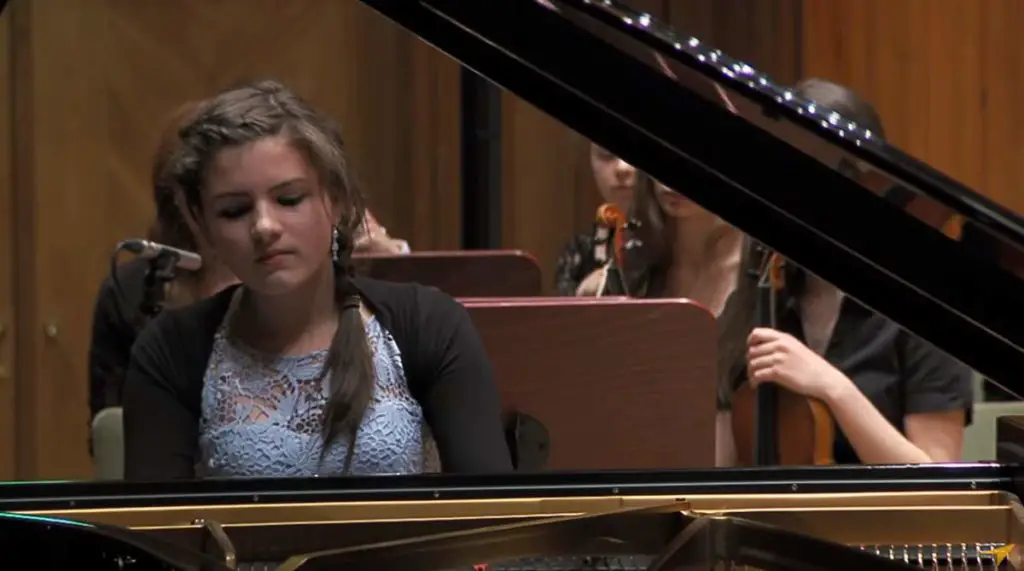Accompanied by the Japan Philharmonic Orchestra, the Japanese pianist Hayato Sumino performs Rhapsody in Blue, a 1924 musical composition written by George Gershwin for solo piano and jazz band, which combines elements of classical music with jazz-influenced effects. Conductor: Kanade Yokoyama. In addition to piano, Sumino also plays melodica. Recorded on February 3, 2021, at the Suntory Hall, Tokyo.
George Gershwin’s Rhapsody in Blue
Rhapsody in Blue” is a renowned musical composition by the American composer George Gershwin. It is considered a groundbreaking work that blends elements of classical music with jazz and popular music, creating a unique and distinctive sound. Gershwin composed the piece in 1924, and it premiered in New York City with the composer himself on the piano.
The composition is characterized by its rich harmonies, syncopated rhythms, and vibrant melodies. “Rhapsody in Blue” is structured (as its name suggests) as a rhapsody, which is a free-flowing musical form that allows for improvisation and a sense of spontaneity. It features a wide range of instruments, including the piano, various brass and woodwind instruments, strings, and percussion, all contributing to its dynamic and colorful orchestration.
The piece opens with a memorable clarinet solo, which has become one of the most recognizable motifs in classical music. The clarinet’s melancholic and soulful melody sets the stage for the lively and energetic sections that follow. Throughout the composition, Gershwin seamlessly transitions between different musical styles, incorporating elements of jazz, blues, and even hints of Latin rhythms.
“Rhapsody in Blue” captures the spirit and energy of the bustling city life of 1920s America, particularly the vibrant atmosphere of New York City. It reflects the era’s optimism, excitement, and cultural diversity. The composition has been widely celebrated for its innovation, pushing the boundaries of traditional classical music and introducing elements of popular music into the orchestral repertoire.
The lasting appeal of “Rhapsody in Blue” lies in its ability to bridge the gap between different musical genres and captivate audiences from various backgrounds. Its infectious melodies, lively rhythms, and evocative harmonies have made it a beloved and frequently performed piece in both classical and popular music settings. “Rhapsody in Blue” remains a testament to Gershwin’s musical genius and his ability to create timeless and captivating compositions that continue to resonate with listeners to this day.
The Story Behind George Gershwin’s Rhapsody in Blue
On January 3rd, 1924, George Gershwin was playing pool with a friend at the Ambassador Billiard Parlor in Manhattan. His brother Ira walked in carrying an early edition of the New York Tribune, which revealed that band leader Paul Whiteman had announced a concert just six weeks away. The article mentioned that a new piece by George Gershwin would be featured.
This news surprised both Ira and George. The following morning, George had a phone call with Paul Whiteman, reminding him that he had declined the request to write a concerto months ago, citing the lack of time for such a task. However, Paul explained that he had made the announcement to beat his rival, Vincent Lopez, who was about to announce his own concert series. George reluctantly agreed to compose the piece.
With less than six weeks remaining, George hoped to work on the composition during train rides between New York and Boston, where he had a new musical in preview. The sounds and rhythms of the train inspired parts of the score. George envisioned the piece as a musical kaleidoscope of America, representing its diverse population, energetic spirit, and metropolitan chaos.
Originally named “American Rhapsody,” Ira suggested the title “Rhapsody in Blue” after visiting an art gallery featuring paintings with color-themed titles. The composition premiered on February 12th as part of an experimental concert. Despite the four-hour duration and chilly venue, notable musicians of the time attended, including John Philip Sousa, Victor Herbert, Walter Damrosch, Fritz Kreisler, and Igor Stravinsky.
As Gershwin’s rhapsody began, the audience experienced the unexpected-a memorable clarinet trill and glissando that became synonymous with the composer. Gershwin improvised several piano passages, which he later transcribed. The effect on the audience was profound, leading to thunderous applause and the concert being hailed as a success.
That night, the history of American music changed. Gershwin’s composition, though rough and unconventional, signaled a potential blending of classical and popular elements, defying expectations. While not all critics appreciated it initially, the New York Times review acknowledged Gershwin’s extraordinary talent and originality, stating that his composition captivated listeners with its intriguing themes, rhythms, and the sensation of a new talent finding its voice.
Sources
- Rhapsody in Blue on Wikipedia

![Khatia Buniatishvili performs Rhapsody in Blue [Gershwin]](https://cdn-0.andantemoderato.com/wp-content/uploads/2023/05/Khatia-Buniatishvili-performs-Rhapsody-in-Blue-1024x576.jpg)
